I first fell in love with a Tassel Berry tree at the Hluhluwe Game Reserve Hilltop Camp. It was old, gnarled and shaped by the prevailing wind. By contrast, the tree in our garden leads a sheltered life.
The Tassel Berry (Antidesma venosum) tree is known to attract fructivorous birds that eat the berries and many insect pollinators that feed on the flowers and in turn attract insectivorous birds. Our tree was planted in 2004 in memory of my mother-in-law who had a fondness for wild birds and nature in general.

Our Tassel Berry tree displaying the catkin-like racemes bearing tiny pale flowers
We bought the tree as a small potted sapling, not knowing if it would ever bear fruit, as Tassel Berry trees have male or female flowers on separate trees, with only the female flowers going on to bear fruit. I can’t remember which year it was when we were pleased to find the tree bearing a few tassels of berries, but it has gone on to produce more fruit each season, with this year being particularly bountiful.

Tassels of green berries on our Tassel Berry tree in April
The berries on the Tassel Berry tree do not all ripen at the same time. At first only a few berries ripen and then a few more and then a few more, so as the fruit-bearing season goes on, berries from pale green through shades of pink and red to the dark purple of the ripest berries can be found on the same clusters or tassels of berries.
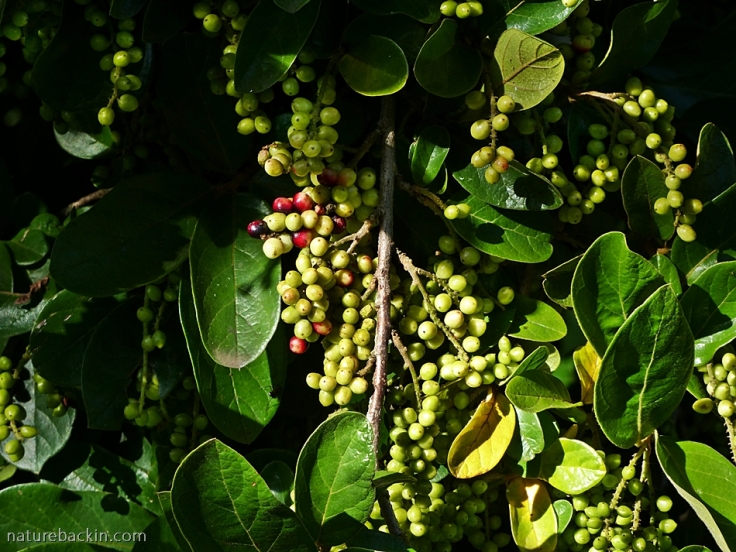
The first few berries in a cluster that are starting to ripen
Because the ripening of the berries happens in such a variable fashion with the first berries ripening in early May, now, three months later, the tree still has a profusion of berries at different degrees of ripeness. Consequently, the tree offers edible fruit throughout the months of winter. In our garden I have seen bulbuls, robins, Purple-crested Turaco, thrushes, sunbirds and Cape White-eyes after the berries. I have also seen Drongos in the tree at fruiting time but I am not sure if they are eating berries or finding insects.
Although there are many birds attracted to the tree they tend to eat when concealed inside the canopy of the tree and they are difficult to photograph as in addition to being hidden in the foliage they are wary of being approached. Interestingly, one of the common names for the tree in Afrikaans is voëlsitboom and one of the several Zulu names for the tree is umhlalanyoni, both of which approximate to meaning resting or sitting place/tree of birds.

A sunbird in the Tassel Berry tree during the fruiting season
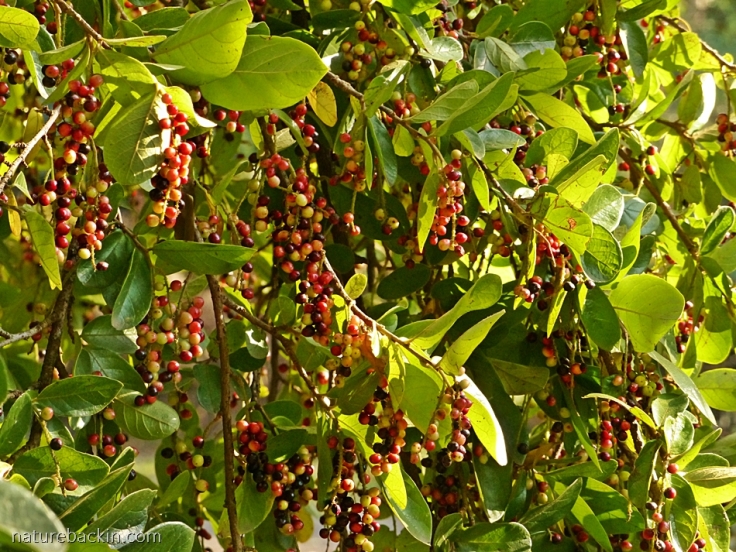
Berries of varying ripenesses in abundance in the Tassel Berry tree in mid-July this year
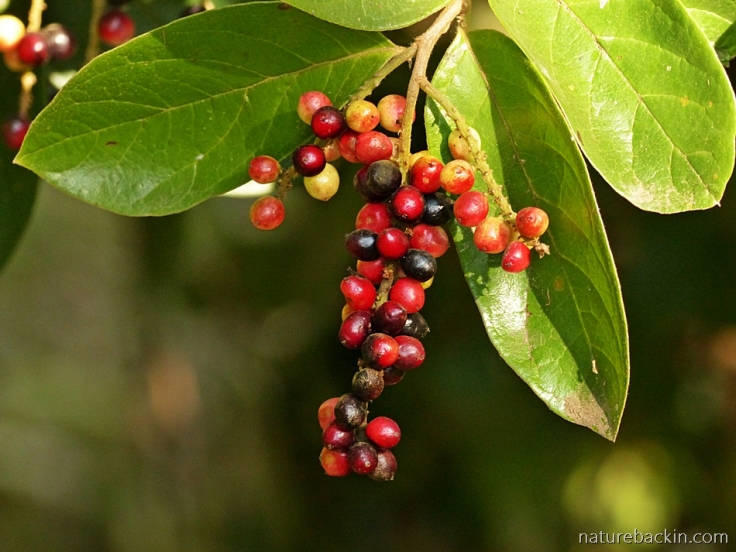
The berries are small, being slightly smaller than the average garden pea, each with one seed. They sweeten as they ripen though they can still be quite sour. They are edible to people, though I have yet to try one
In the wild the leaves are browsed by many animals (including elephant and several antelope) and in addition to many birds, many mammals eat the fruit (antelope, baboons and Vervet monkeys, and nocturnal animals such as bats, civets and genets). Fruits that are helpfully dropped to the ground are eaten by bushpig, antelope, francolins and many insects too. All play their part in seed dispersal.
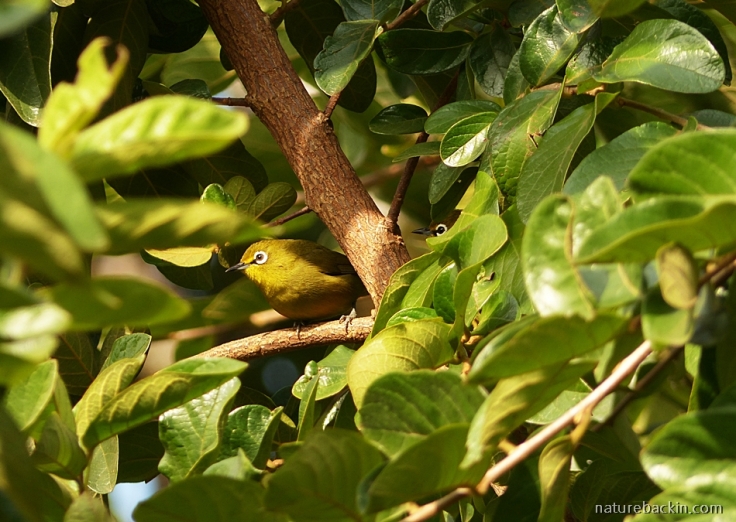
Cape White-eyes (one largely concealed) in the Tassel Berry tree
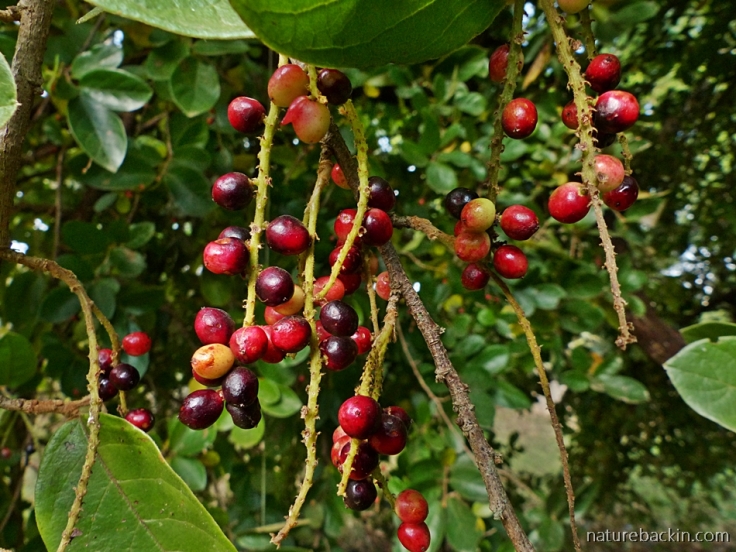
As the season progresses, the long tassels gradually get picked clean of the riper berries

Usually the riper berries seem to be preferred, but some ripe berries remain on these tassels. To grow from seed, it is best to pick ripe berries and then dry them in the shade to remove the flesh before planting them in seed trays
The Tassel Berry tree occurs naturally mostly at forest margins at lower altitudes and grows along the eastern seaboard of Africa from the Eastern Cape in the south to the Sudan in the north. The trees are deciduous or partly deciduous depending on rainfall patterns. In our garden, the tree loses most of its leaves at the end of the fruiting season in late winter into early spring
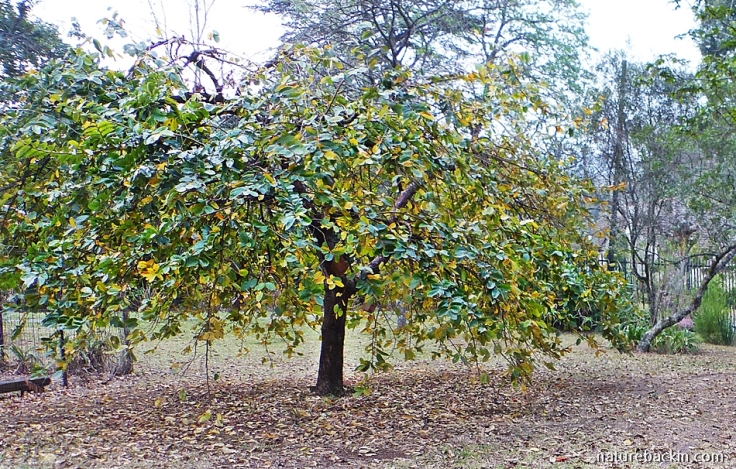
The Tassel Berry tree in our garden at the end of a very dry winter in September 2017
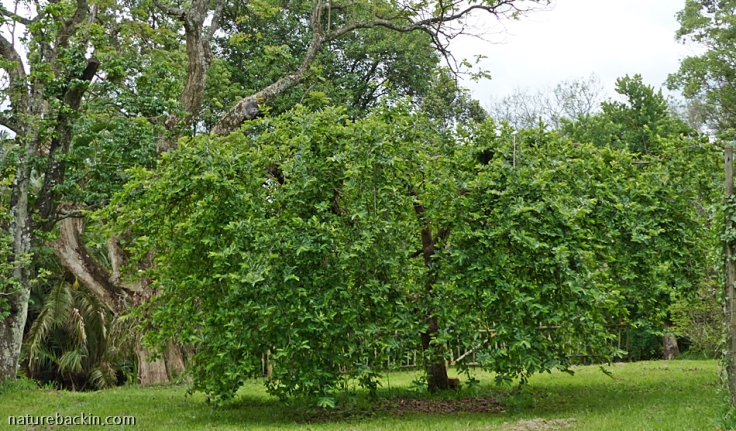
The Tassel Berry tree looking somewhat leafier in a much greener space in December 2017 after some early summer rain. The tree gains a more weeping habit as it gets older making it easier for ground-dwelling animals to browse or forage in the lower branches. In our garden Vervet monkeys often eat fruits from the tree while standing on the ground on their hind legs
As lovely and busy as the tree is when fruiting, it is also a very dynamic space during the flowering season. As we only have a female tree, I only have photographs of the long racemes bearing female flowers. The male flowers with conspicuous fluffy stamens are on much longer stalks. The flowers are often described as being smelly or else scented of honey, but I have only noticed a rather vague sweetness. Many insects, most noticeably pollinating flies, come to eat the nectar and pollen.
According to many sources pollinators attracted to Tassel Berry flowers include butterflies and bees, but on our tree I seldom see either, with the predominant pollinators being a variety of flies (see earlier post on flies as pollinators), as well as an intriguing variety of insects abundant among the flowers.
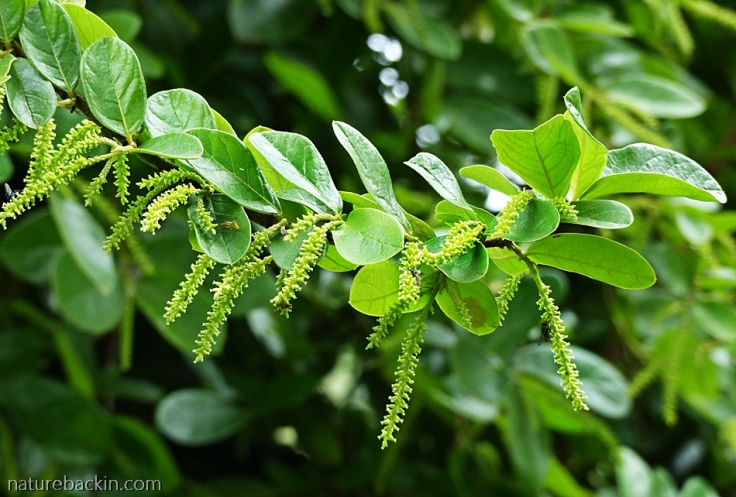
Tassel Berry flowers early in the season. On the right-hand raceme a fly can just be seen, perhaps providing some perspective on how tiny the flowers are. This photograph was taken in mid-February

A colourful blow fly feeding on the tiny flowers that are still a very pale yellow, in early February
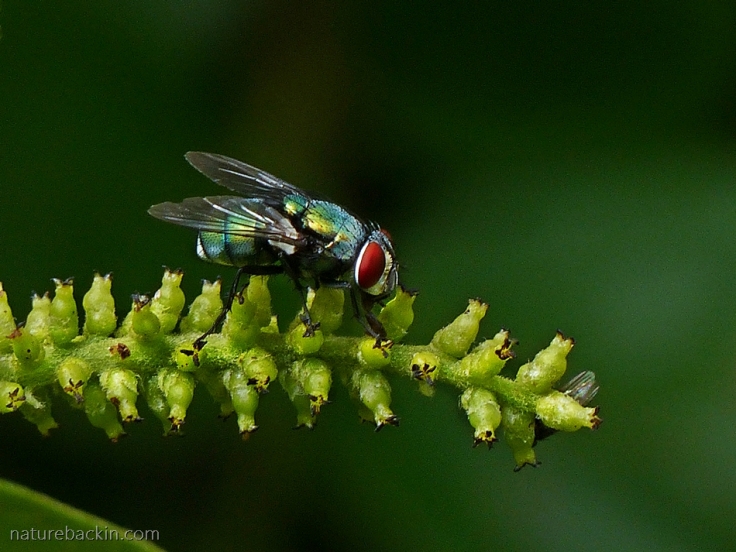
By the end of February the flowers are starting to go over and are noticeably brown
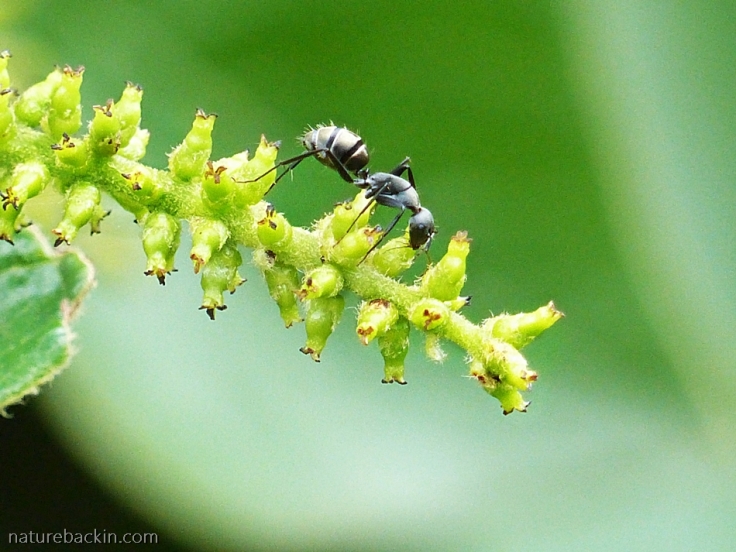
An ant savouring the delights of the Tassel Berry flowers

I spotted this net-winged beetle visiting the Tassel Berry tree during February

A species of hover fly feeding from a flower
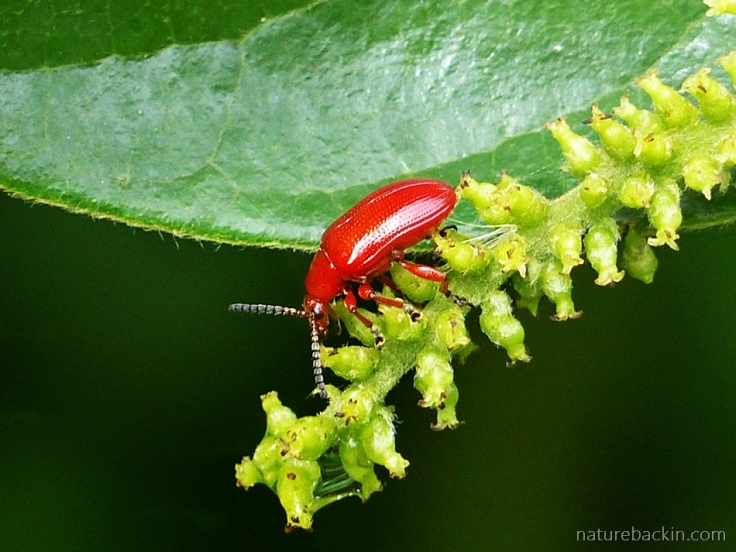
A strikingly colourful and tiny leaf-beetle feeding among the Tassel Berry flowers
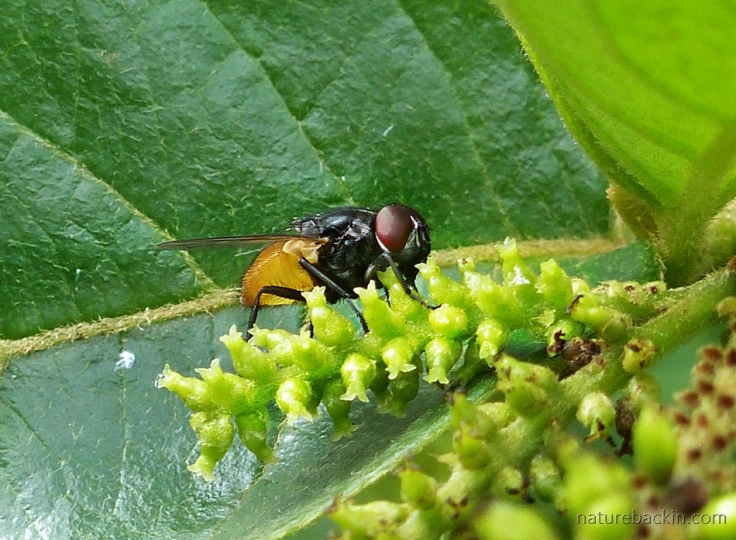 Another of the several species of fly that visit the flowers, acting as vital pollinators in the process
Another of the several species of fly that visit the flowers, acting as vital pollinators in the process
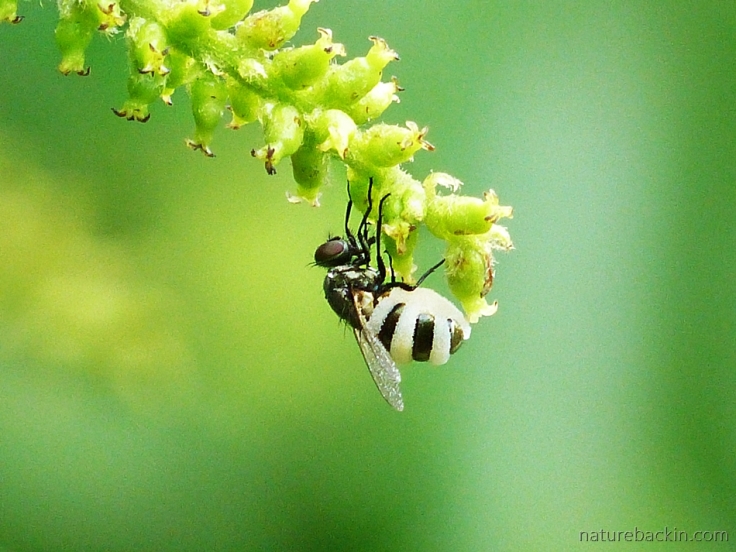
A stripy house fly
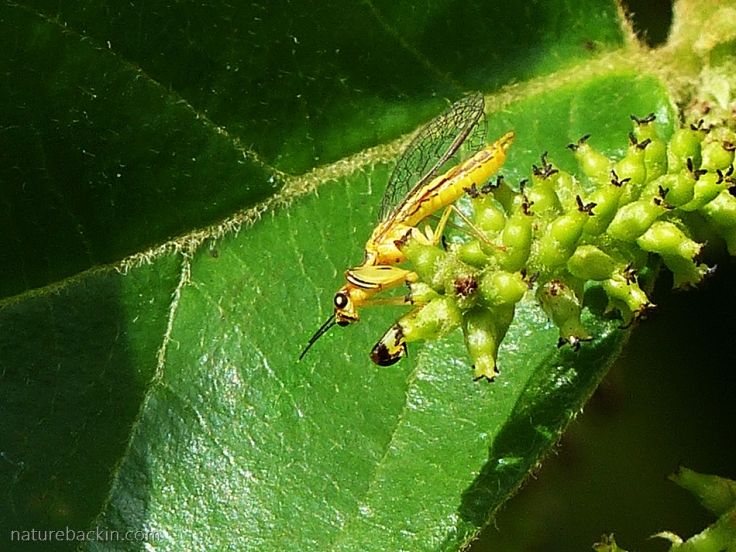
Above and below are very tiny mantis-like creatures. I think they might be mantidflies (mantispids), which I had not heard of before. They cannot rotate their heads like proper mantises, but they do have relatively strong and large forelimbs for catching insects

The mantisfly above is extending its right forelimb showing its size and power. I assume they are attracted to the Tassel Berry tree to catch the insects that arrive to feed on the flowers. I had not seen these tiny insects before and I found them to be most entrancing. Really they are too small to be captured by my camera lens but I couldn’t resist giving it my best shot
Sources:
Boon, Richard. 2010 (2nd ed.). Pooley’s Trees of Eastern South Africa. Durban: Flora & Fauna; Nichols, Geoff. 2013. Antidesma venosum (Tassel-berry). Flora and Fauna Publications Trust. http://www.floratrust.co.za/blog/cat/snippets-fyi/post/Antidesma-venosum-Tassel-berry/; Picker, Mike, Griffiths, Charles & Weaving, Alan. 2019. Field Guide to Insects of South Africa. Cape Town: Struik Nature; Venter, Fanie & Julye-Ann. 1996. Making the Most of Indigenous Trees. Pretoria: Briza.
Posted by Carol









August 18, 2019 at 9:35 pm
How wonderful to have observed all these species on your tree. Gorgeous photography, too. 😀
)P.S. I’ve really been enjoying catching up on your posts, Carol!)
-Emma
LikeLiked by 1 person
August 19, 2019 at 6:13 am
Thank you Emma and good to see you back in the blogging world and to read about the momentous developments especially the arrival of Ezra.
LikeLiked by 1 person
August 9, 2019 at 8:32 am
Thank you (re: father)
He has always been obsessed with his garden. But like me, his garden is only food. True. Maybe his illness has opened his heart.
Laughing, “I am not a fan of nonfood plants normally”. Just realized Papa and I forget nonfood plants are food for nonhumans. Mind shifts sometimes happen slowly. Read your blog yesterday and my brain is only highlighting this today.
Pleasure (bats).
He loves me an inkling more now. He is finding a spot on the yard to plant a tassel berry.
Thanks for the lovely blog and chat.
LikeLiked by 1 person
August 9, 2019 at 2:28 pm
Thanks – how nice to connect via our blogs 🙂 Thank you.
Yes it is nice to think that in the bigger scheme of things most plants are food plants in one way or another!
All power to the tassel berry tree. Bear in mind that only female trees bear fruit, and they need male trees somewhere around the neighbourhood for pollination. We are lucky that our tree somehow gets pollinated as we have just the one.
LikeLiked by 1 person
August 9, 2019 at 5:30 pm
Thanks for the reminder/warning. He is thorough in his approach to planting, he reads at least a dozen books (chest propped up) that I bought him second hand on bidorbuy and he has access to the university research which he reads about every tree before he plants it. Even drove all the way to PMB to find some trees, can’t remember what they were as they died upon transplanting. All this is to say, he will probably find out and I will hold on to this reminder until the day he holds the shovel to ask him if he knows, to test if I am right about him.
To the tassel berry tree, xx
LikeLiked by 1 person
August 9, 2019 at 7:26 pm
To the tassel berry tree indeed 🙂
LikeLiked by 1 person
August 8, 2019 at 1:41 pm
“Our tree was planted in 2004 in memory of my mother-in-law who had a fondness for wild birds”. I got stuck here, read it a couple if times not knowing asking my brain why this made me feel awe. Now I am debating whether it was because I have not seen a gesture of affection towards some one who has passed in this format (I live under a rock yes) or whether I wanted to steal it for my fragile sick father who is in his 80s. The last day if visiting me he said to my mother, “Mommy, before we leave walk with me so I can take you to the most beautiful part of my daughter’s garden. Let us walk together in the garden of Eden.” He took mother to an overgrown weed with droopy red flowers at the end of the garden. We didn’t cut it after he asked for photos with the alien plant (Turk’s cap, Malvaviscus arboreus).
Oh wow, my boyfriend will be happy when I tell him I’ve been reading about an indigenous plant (I am not a fan of nonfood plants normally). He’s been trying to invite bats to our garden and it has failed so far. Wait let me ask if he knows this plant.
Uh excellent, he doesn’t know about it. He says, ‘Know what? I’ve looked at the description but I think it’s not edible so I wasn’t very interested.
Does it have something to do with bats or owls?’
Excuse me while I go and impress him with my newly acquired knowledge about attracting his bats and owls.
Thanks xx
LikeLiked by 1 person
August 9, 2019 at 6:22 am
I am really sorry that your father is so sick and fragile. I like though that he loves the beauty of an “ordinary” red flower and no matter what its origin and conventional status. I have seen that for some people serious illness opens their hearts to “simple” and natural things that we tend to take for granted. Planting a tree seems to be a gesture of gratitude and optimism?
And wow, I had not thought about plants actively attracting bats! You have started a new train of thought. Thank you! I hope that your boyfriend is also suitably impressed 🙂
Wishing you and your father well.
LikeLike
August 4, 2019 at 10:09 am
A true feast for so many different animals! Very interesting post. I like especially the different colours of the berries. They are very photogenic!
LikeLiked by 2 people
August 9, 2019 at 5:55 am
I agree about the berries – the varying colours are most striking. Thank you Simone.
LikeLiked by 2 people
August 3, 2019 at 1:24 pm
This is particularly timely as I was sitting just yesterday, watching the bees, and realised that there were at least as many flies as there were bees busy on the flowers. I had no idea they were pollinators. Another fascinating and informative post – and such an array of colourful insects!
LikeLiked by 2 people
August 9, 2019 at 5:54 am
Thank you Sandra. Mostly flies have such a malign reputation, but they just do what they do and a lot of that is actually beneficial to us humans too!
LikeLiked by 2 people
August 3, 2019 at 7:52 am
What a lovely post.I learnt so much from this and your photographs are stunning. Loved the pics documenting stages through the year.
LikeLiked by 1 person
August 9, 2019 at 5:51 am
Thanks so much Carol
LikeLike
August 3, 2019 at 4:07 am
Another very interesting post. Love all the bug photos and how diverse they are. The ecosystem is just worlds within worlds isn’t it? If only we humans could appreciate that and work with it instead of trying to exploit everything.
LikeLiked by 1 person
August 9, 2019 at 5:49 am
Thank you Graham. And if not actively exploiting we tend to walk rough shod over everything with no insight into the consequences.
LikeLiked by 1 person
August 2, 2019 at 7:08 am
I really think you should try the berries. Who knows… you might discover the cure for colds???
LikeLiked by 1 person
August 2, 2019 at 7:27 pm
As I replied to Margaret, I did try the berries this morning. They don’t yield very much, but they are not unpleasant. Traditionally medicines made from various parts of the tree were mostly used to treat stomach complaints, but I would guess that the fruits would have as much Vitamin C as most other berries. One would have to eat a lot though to get much sustenance into one’s system!
LikeLiked by 1 person
August 2, 2019 at 7:04 am
Tree of Birds — what a lovely name. And what a lovely tree. Not to mention those spectacular photographs of insects eating the berries. And all that I have learnt by reading your post. Thank you.
LikeLiked by 3 people
August 2, 2019 at 7:24 pm
Thanks very much Mariss. Most of the insects were attracted to the flowers rather than the berries, but it is the berries that are so eye-catching and appealing to the birds.
LikeLike
August 2, 2019 at 6:32 am
Nature at its best and what awesome pictures. Too good.
LikeLiked by 1 person
August 2, 2019 at 7:22 pm
Thanks very much Kamal 🙂
LikeLike
August 3, 2019 at 3:46 am
Welcome 😊😊😊😊😊
LikeLiked by 1 person
August 2, 2019 at 5:43 am
What a wonderful tree to have in your garden. It looks as if a great variety of creatures call in for a snack. I can’t believe you haven’t tried the berries too!
LikeLiked by 2 people
August 2, 2019 at 7:22 pm
Well, of course after reading your comment, I have tried the berries 🙂 I sampled one berry at a time, scraping the rather fibrous pulp off the relatively large, hard seed with my teeth. I chose the ripest berries and they are sweetish but the skin can be a bit tart and the astringency built up after only about 6 berries. The amount gleaned from one berry is really very, very little, even relative to the size of the berry. One might pick a few off the tree to sample, but they are not the sort of fruit one might settle down with a handful to savour. Best left to the birds and other creatures in my opinion 🙂
LikeLiked by 2 people
August 2, 2019 at 7:33 pm
That sounds fair. You wouldn’t have wanted to fall out with them by scoffing the lot 😉
LikeLiked by 1 person
August 2, 2019 at 7:33 pm
🙂
LikeLiked by 1 person
August 2, 2019 at 4:48 am
Wonderful photographs! Your patience and thorough approach to your subjects make each of your posts something to look forward to!
LikeLiked by 2 people
August 2, 2019 at 7:12 pm
Thank you very much Anne. This tree is a rich resource for me too 🙂
LikeLike
August 2, 2019 at 3:42 am
A whole natural world within one tree, so lovely Carol! xxx
LikeLiked by 2 people
August 2, 2019 at 7:10 pm
Yes it is a kind of world in one tree, thanks Christeen.
LikeLiked by 1 person
August 2, 2019 at 3:05 am
Another very informative post, Carol. I, and all your other followers too I amsure, really appreciate the time and effort you take to prepare these!
I love sitting near a tassel-berry when bird-watching in Zululand – there’s bound to be something interesting along soon, either for the berries or for the goggas!
LikeLiked by 3 people
August 2, 2019 at 7:09 pm
Thank you very much Dries. Interesting that you also associate this tree with Zululand. The plants that provide sustenance in the winter are a big draw-card.
LikeLiked by 1 person
August 2, 2019 at 1:11 am
An informative and interesting post with great photos, Carol. This tree clearly plays a vital role in the ecosystem!
LikeLiked by 1 person
August 2, 2019 at 7:06 pm
Thanks very much Eliza. This tree does make a huge contribution, getting pollinated and its seeds effectively dispersed as a result 🙂
LikeLike
August 1, 2019 at 11:00 pm
Your best shot is more than good enough for me. What a fantastic look into these varied tiny creatures that are all a part of the tapestry of life. Splendid post, as always! Such a pleasure to visit your blog.
LikeLiked by 2 people
August 2, 2019 at 7:04 pm
Thanks so much Gunta. It has been nice to share my peek into just some of the life attracted to a single tree.
LikeLike
August 1, 2019 at 10:46 pm
is wine or jam made from the berries?
LikeLiked by 1 person
August 2, 2019 at 7:02 pm
A good question, but it seems not, probably because the berries are so small with little yield. The bulk of the berry is a hard seed and the seed is covered by a thin layer of pulp and then a skin similar in thickness to a grape’s. Each berry produces only a minute amount of pulp so it would take a lot to produce even a tablespoon of anything usable.
However, all parts of the tree (root, bark, leaves, fruit) have been used medicinally.
LikeLike
August 2, 2019 at 7:17 pm
Thank you!
LikeLiked by 1 person
August 2, 2019 at 7:30 pm
🙂
LikeLike